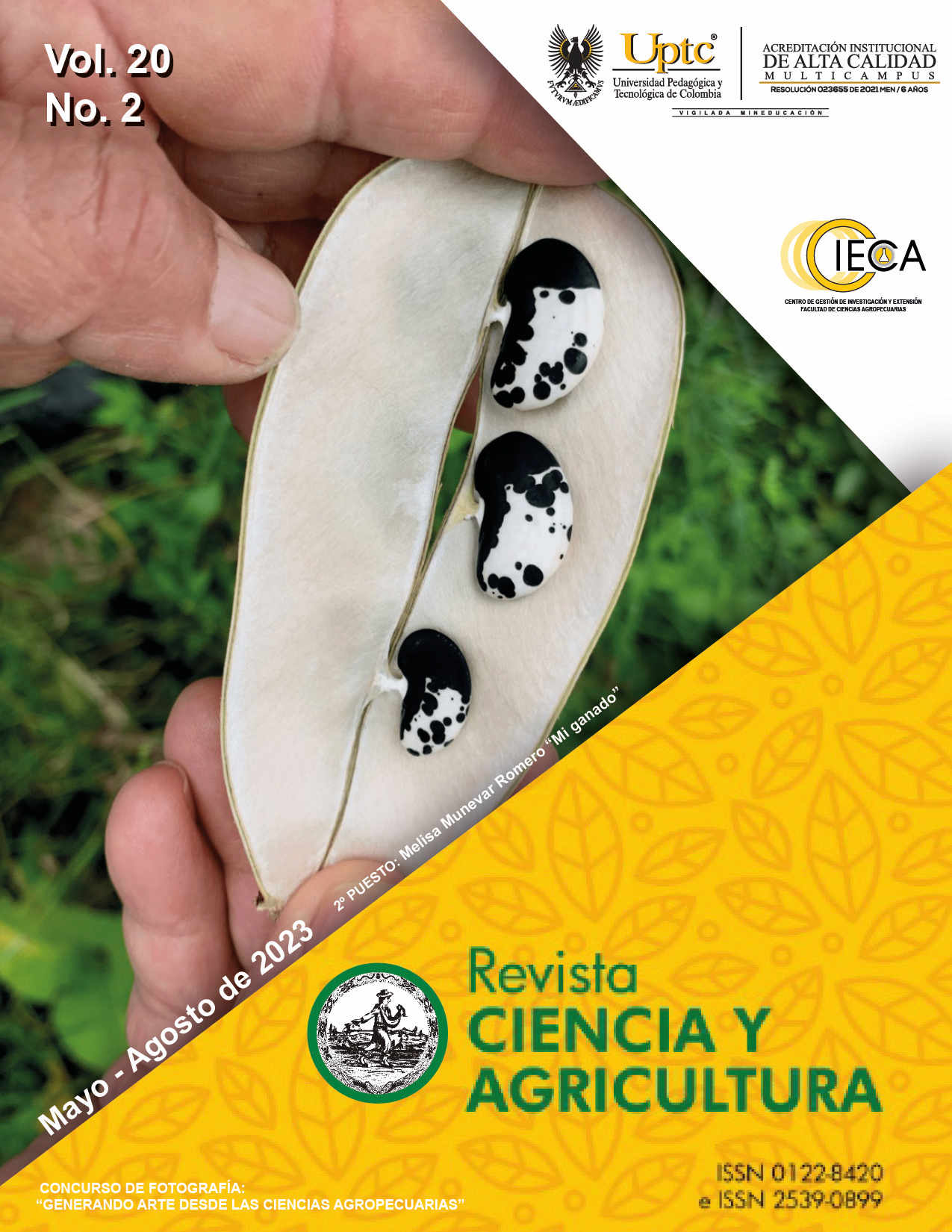Typology of Pea Producers (Pisum sativum L.) in the Municipalities of Córdoba and Puerres, Nariño, Colombia

Abstract
Fresh pea is the second most important legume in Colombia after beans. In the last 15 years, the cultivated area in the country has increased, and the department of Nariño contributes 58% of the national production. The production area is concentrated in the subregion of former province of Obando, in the south of the department, and is cultivated mainly by smallholders. This crop is one of the most representative agricultural production systems in the region, a key element of food and nutrition security and one of the main sources of income for rural families. This study identified the typologies of producers in the municipalities of Puerres and Córdoba (Nariño) based on a sample of 117 peas to which a structured survey was applied; the data were analyzed using a hierarchical method and four groups of adopters were established. The main differentiating variables were socio-demographic variables, crop experience, technology adoption and its relationship with quality of life and migration processes. This type of analysis contributes to several purposes, from understanding to a certain extent the complexity of rural societies, as well as defining public policies and identifying key aspects for technology adoption.
Keywords
Vegetables, Typology, Smallholders, Technology adoption
References
- Alcaldía de Córdoba. (2018). Plan de desarrollo ‘Construyendo unidos el futuro de Córdoba: nuestro Municipio’. http://www.cordoba-narino.gov.co/
- Alcaldía de Puerres. (2016). Plan de Desarrollo ‘Hicimos historia, construimos futuro 2016-2019’. http://www.puerres-narino.gov.co/
- Álvarez-Sánchez, D., & Gómez-López, E. (2020). Estimación de la sustentabilidad de fincas productoras de arveja en el municipio de Ipiales, Nariño-Colombia. Revista U.D.C.A Actualidad & Divulgación Científica, 23(1). https://doi.org/10.31910/rudca.v23.n1.2020.1578 DOI: https://doi.org/10.31910/rudca.v23.n1.2020.1578
- Álvarez-Sánchez, D., Gómez-López, E. D., & Ordóñez-Hurtado, H. R. (2019). Tipología de fincas productoras de arveja (Pisum sativum L.) en la subregión Sur de Nariño, Colombia. Ciencia & Tecnología Agropecuaria Agropecuaria, 20(3), 659–677. https://doi.org/10.21930/rcta.vol20_num3_art:1593 DOI: https://doi.org/10.21930/rcta.vol20_num3_art:1593
- Botia-Carreño, W. H. (2019). Unidad Agrícola Familiar (UAF), instrumento de política pública agropecuaria en Colombia. Pensamiento y Acción, 27, 59-89.
- Cadena, A. M., Riascos, M. E., Castro, A., Delgado, A. M., Zambrano, G., & Vásquez, A. R. (2022). Impacto de las variedades Obonuco Andina y San Isidro en el departamento de Nariño, Colombia. Revista de Investigaciones Altoandinas, 24(4), 257–266. https://doi.org/10.18271/ria.2022.452 DOI: https://doi.org/10.18271/ria.2022.452
- Cano, C. G., Ramírez, M. T., Tribín, A. M. & Iregui, A. M.(Eds.). (2017). El desarrollo equitativo, competitivo y sostenible del sector agropecuario en Colombia. Banco de la República.
- Checa, O. E., Rodríguez, D. M., Ruiz, M. H., & Muriel, J. E. (2022). La arveja: Investigación y tecnología en el sur de Colombia. Universidad de Nariño. http://sired.udenar.edu.co/id/eprint/7303
- DANE, Departamento Administrativo Nacional de Estadística Colombia. (2018). Censo Nacional de Población y Vivienda 2018. https://www.dane.gov.co/index.php/estadisticas-por-tema/demografia-y-poblacion/censo-nacional-de-poblacion-y-vivenda-2018
- FENALCE, Federación Nacional de Cultivadores de Cereales, Leguminosas y Soya Colombia. (2023). Histórico de área, producción y rendimiento: cereales y leguminosas [base de datos]. https://app.powerbi.com/view?r=eyJrIjoiM2FiYzM5ZTAtNjFmNi00MGQyLWFiYzYtNGI0YTJiZTcwZWQwIiwidCI6IjU2MmQ1YjJlLTBmMzEtNDdmOC1iZTk4LThmMjI4Nzc4MDBhOCJ9
- Goswami, R., Chatterjee, S., & Prasad, B. (2014). Farm types and their economic characterization in complex agro-ecosystems for informed extension intervention: study from coastal West Bengal, India. Agricultural and Food Economics, 2(1), Artículo 5. https://doi.org/10.1186/s40100-014-0005-2 DOI: https://doi.org/10.1186/s40100-014-0005-2
- Hamann-Salcedo, F. A., Arias-Rodriguez, F., Bejarano-Rojas, J. A., Gáfaro-González, M. M., Méndez-Vizcaíno, J. C., & Poveda-Olarte, A. (2019). Productividad total de los factores y eficiencia en el uso de los recursos productivos en Colombia. Ensayos Sobre Política Económica, 89, 1–54. https://doi.org/10.32468/espe.89 DOI: https://doi.org/10.32468/espe.89
- INCORA, Instituto Colombiano de la Reforma Agraria Colombia. (1996). Resolución No. 041 de 1996. Determinación de extensiones para las UAFs: Por la cual se determinan las extensiones de las unidades agrícolas familiares, por zonas relativamente homogéneas, en los municipios situados en las áreas de influencia de las respectivas gerencias regionales. https://planeacion.boyaca.gov.co/descargas/Normatividad_Pots/resolucin%20041%201996.pdf
- Johnson, R. A., & Wichern, D. W. (2007). Applied multivariate statistical analysis (6th Ed). Pearson Modern Classics.
- Lozano, J. L. & García, D. (2018). Envejecimiento rural en la localidad de Sumapaz, Bogotá D.C., 2014-2016. Opinión Pública, 10, 33–41. https://revistas.cun.edu.co/index.php/opinionpublica/article/view/544/398 DOI: https://doi.org/10.52143/2711-0281.544
- MADR, Ministerio de Agricultura y Desarrollo Rural Colombia. (2020). Cadena de la papa – Cifras sectoriales. Junio 2020. https://sioc.minagricultura.gov.co/Papa/Documentos/2020-06-30%20Cifras%20Sectoriales.pdf
- Mądry, W., Mena, Y., Roszkowska-Mądra, B., Gozdowski, D., Hryniewski, R., & Castel, J. M. (2013). An overview of farming system typology methodologies and its use in the study of pasture-based farming system: a review. Spanish Journal of Agricultural Research, 11(2), 316. https://doi.org/10.5424/sjar/2013112-3295 DOI: https://doi.org/10.5424/sjar/2013112-3295
- Nyambo, D., Luhanga, E. T., & Yonah, Z. Q. (2019). A review of characterization approaches for smallholder farmers: Towards predictive farm typologies. Scientific World Journal, 2019, Artículo 6121467. https://doi.org/10.1155/2019/6121467 DOI: https://doi.org/10.1155/2019/6121467
- Rozo, Y., Romero, Y., & Tofiño, A. P. (2020). Aspectos sociales y culturales de la producción de hortalizas en la región Caribe de Colombia. In A. M. Martínez El cultivo de hortalizas en la región Caribe de Colombia. Aspectos tecnológicos, económicos y de mercado (pp. 31–55). AGROSAVIA. https://doi.org/https://doi.org/10.21930/agrosavia.investigation.7404074 DOI: https://doi.org/10.21930/agrosavia.investigation.7404074
- Saravia, S., Cimpoies, D., & Ronzon, T. (2013). Panorama of typologies of agricultural holdings. FAO. https://www.fao.org/3/bl333e/bl333e.pdf
- Torres-Martínez, F. J., Rivadeneira-Miranda, C. N., & Castillo-Marín, Á. J. (2020). Producción y comercialización de arveja en el departamento de Nariño-Colombia. Agronomía Mesoamericana, 31(1), 129–140. https://doi.org/10.15517/am.v31i1.36776 DOI: https://doi.org/10.15517/am.v31i1.36776
- Villota, L. J. (2023). Caracterización y sostenibilidad del emprendimiento social rural en agronegocios asociativos al sur de Nariño. Tendencias, 24(1) 50–78. https://doi.org/10.22267/rtend.222302.215 DOI: https://doi.org/10.22267/rtend.222302.215
- Weller, J. (Ed.) (2016). Brechas y transformaciones: la evolución del empleo agropecuario en América Latina. Comisión Económica para América Latina y el Caribe (CEPAL). https://doi.org/10.18356/daa2f77a-es DOI: https://doi.org/10.18356/daa2f77a-es
- Zuluaga-Mogollón, M. (2019). Adopción tecnológica como estrategia de desarrollo local: "el acaso de las variedades de arveja Obonuco Andina y San Isidro en los municipios de Córdoba y Puerres, Nariño, Colombia. 2000-2015 [Tesis de maestría, Universidad Pedagógica y Tecnológica de Colombia].
